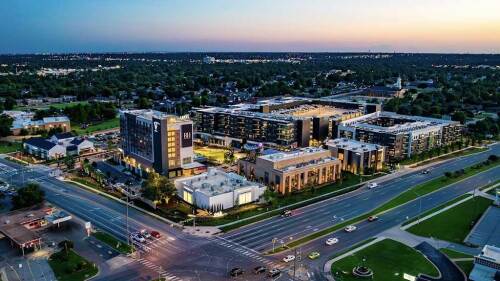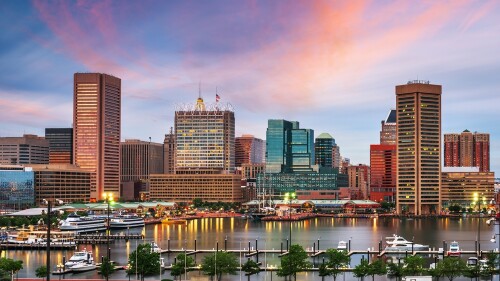It is time to start looking at strip centers as potential linear villages so that what forms over time is a better balance of uses with the right transportation options to enable people to move about the corridor.
After the single-family detached house, nothing typifies the American suburb more than its arterial commercial corridors. These “in between” spaces of a city that connect activity centers are typically overlooked as places of new market opportunities. As a result, long-neglected corridors across the country are plagued with haphazard development patterns. Especially over the last two decades, city leaders and developers alike have focused on improving downtowns, creating new town centers, and adding lifestyle additions to malls. More often than not, the low-intensity, general commercial zoning along corridors has been untouched for years.
Today, regional and local planning agencies are turning their attention to the most challenging elements of our built communities—the main arteries—and preparing the way for a strategic response from the development community. Mark Butala, manager of comprehensive planning for the Los Angeles–based Southern California Association of Governments (SCAG), observes that “increasingly, underused commercial corridors in suburban areas are seen as an opportunity for investment that creates multiuse, mixed-income communities while limiting change in the often politically sensitive established neighborhoods.” Projects such as Life on State in Utah; the Corridor Pilot Projects in Chino, California; and a new corridor development project in Fremont, California, illustrate how jurisdictions are laying the groundwork for this kind of corridor revitalization.
The evolution of the modern corridor dates to the Land Ordinance of 1785, which established the township and range basis for land surveys and provided for conveying title to land through deeds of one-square-mile lots. The resulting one-mile rectangular grid defines the built environment and the public right-of-way network of arterial highways and corridors for most of the country west of the Appalachian Mountains. Over time, corridors have evolved into stand-alone, automobile-dominated linear environments that are challenging to retrofit as productive, multimodal places that integrate well with the community.
Results of Excess Retail along Corridors
Excess retail is usually one of two types: short term or structural. Short-term vacancies occur as individual businesses relocate, close branches, or fail. As long as there is sufficient consumer spending to support the retail building space in the trade area, then it is usually only a matter of time before vacancies are filled. Long-term structural vacancies, however, afflict portions of most corridors that developers and communities eye for redevelopment and revitalization. These vacancies exist where household spending is insufficient in the trade area to support the retail building space. When some owners begin asking lower rents, other owners may be forced to lower rents just to maintain their current tenants, leading to a downward spiral in the trade area. The areawide lowering of lease rates leads to lower operating income, which leads to deferred maintenance and a lack of reinvestment over time. Low rents also attract marginal business—adult businesses, seasonal stores, a proliferation of check-cashing operations.
When a corridor has high vacancies, high turnover, and marginal businesses, it has structural vacancy problems, which can deter developers interested in potential commercial infill projects in the local area. New commercial space is less attractive to neighborhood-serving retail and service businesses when there is cheaper space available a block away. It is also more difficult to finance new commercial building space in an over-retailed corridor segment. And the most recent economic recession has only exacerbated corridor conditions.
Why is this so challenging? Unfortunately, local leaders are often resistant to any conversion of retail space to nonretail uses. In some states, the more retail, the more local tax revenue, leading many elected officials to keep corridors zoned for commercial regardless of the retail environment. An alternative model that is much more strategic involves a more purposeful arrangement and grouping of uses along a corridor, which can result in greater economic vitality. Also, corridors play multiple roles in a community: a gateway; a thruway; a place to eat or shop; a place to live or work. Many municipal leaders fail to appreciate the influence that corridors have on the image of a community. In one study on city branding, surveys demonstrated that the built environment, which is largely viewed from the main corridors of a city, played a key role in people’s perceptions of that city, despite efforts to create brand or image based on something else, like a special place or certain attributes. Corridors are important visual indicators of the attention paid to neighborhoods and businesses outside the city centers, and of overall civic pride. They may never be the most culturally or economically elite areas of communities, but they can undermine any brand credibility if neglected.
Life on State: A Multijurisdictional Effort
Declining image was the motivation that joined seven jurisdictions in a multijurisdictional corridor planning project in Salt Lake County. State Street was the major thoroughfare along the Wasatch Front from Provo to downtown Salt Lake City until the construction of Interstate 15. Over the last 40 years, State Street changed from being the center of commerce to a place that is “plagued with lower-value land uses in a setting that is hostile to pedestrians and bicyclists,” says Chuck Chappell, executive director of the Wasatch Front Regional Council (WFRC). In 2009, the WFRC spearheaded the Life on State project (www.LifeOnState.org) with the involvement of Salt Lake County, Salt Lake City, South Salt Lake, Murray, Midvale, Sandy, Draper, the Salt Lake Chamber, the Utah Department of Transportation, and the Utah Transit Authority.
“Life on State was unique in that it was the first time the WFRC tried to connect regional transportation and transit planning in the area with market-based land use recommendations,” according to Chappell. A study sought to identify the right types of infill in the right locations to take better advantage of the urban services in the area (light rail, employment centers, hospital, and entertainment uses). The study documented a market demand for smaller, attached housing types along the corridor that would appeal to downsizing boomers and young adults without children. “It is time to start looking at strip centers as potential linear villages so that what forms over time is a better balance of uses with the right transportation options to enable people to move about the corridor,” Chappell notes. The Life on State project sets the stage for ongoing work by the local jurisdictions to retool their zoning codes and economic development strategies.
Local Efforts to Reposition Corridors
New housing is now increasingly part of the solution to over-retailed corridors. Not all corridor segments are suitable for housing: it needs to fit as part of an overall market-based plan for better organizing origins and destinations along a corridor. Where it is appropriate, cities are responding favorably to a range of new and redesigned multifamily housing products that work on a variety of lots sizes and configurations. Vacant big-box sites and auto dealerships are large enough to appeal to the large-scale rental developer, while smaller, narrower lot configurations are appealing to the niche builder. In most suburbs, vertical mixed use is not viable, but horizontal mixed use is just as effective. It does not matter to a retail business if the customer lives upstairs or next door. What matters is having feet on the street from both nearby jobs and housing.
Context-sensitive design improvements along the right-of-way are also a critical part of this strategy. For multifamily developers facing price-constrained consumers, the shopping, entertainment, and nearby recreational uses along the corridor replace typical project amenities (clubhouse, pool, etc.). The quality of this “ped shed” in turn relies on the commercial developers who create the space, the businesses that operate there, and the local government that provides parks, policing, maintenance, and parking. The ped shed should factor more heavily into where developers locate their next housing project and how they market it.
This concept is part of an overall corridor strategy being considered by the city of Chino in San Bernardino County, California. A large, 100-year-old suburb, the city is evaluating new housing prototypes for several of its major corridors before making zoning changes. The project involves site plan alternatives and pro forma evaluations for eight housing types that currently do not exist anywhere in the city. The housing types were selected according to architectural design criteria important to the city, strong street orientation, and expected market demand. The preferred alternatives for each of the seven sites, based on economic performance, will be part of the public outreach campaign to generate support for new multifamily housing along corridors.
During this economic downturn, smart architecture firms have been developing new housing and mixed-use prototypes that respond to the new economic realities. One such product, pioneered by Thomas Cox Architects in Irvine, California, is designed for urbanizing corridors. Called High DEF, this product is a three- to four-story building with a flexible ground floor that can be designed with residential, retail, office space, and live/work configurations. Designed to create an urban edge along the street, the building provides on-grade parking (1:1 ratio) under the building footprint, with surface parking for guest and retail uses. A former strip center in Fremont, California, will be one of the first applications of this new product. Construction is expected to begin this spring for 188 dwelling units and 26,000 square feet (2,400 sq m) of commercial uses. The city is seeking to transform the Fremont Corridor from a typical strip commercial development pattern to a higher-intensity mixed-use corridor that takes advantage of an adjacent transit station. The site plan creates both an attractive and vertical street edge as well as an internal sense of place through the design of a centralized plaza that will be programmed for regular events, including a farmers’ market. Says Aram Chahbazian, principal of Thomas Cox, “The High DEF product is extremely well suited for cities that are expecting urbanization of their suburban corridor, but without the cost of structured parking.”
Corridor revitalization has broad advantages, including environmental benefits. Butala reports that SCAG has identified corridors throughout southern California as “appropriate areas to absorb future growth, while having the added benefits of reducing car travel and carbon emissions, improving air quality, and preserving valuable open space.” But the repositioning of corridors over time requires a proactive local government with planners, redevelopment specialists, and transportation officials working together to achieve common goals. Developers can also play an important role as both advisers and champions of innovation and high-quality pedestrian or transit-oriented design. In the end, corridor revitalization is about reconnecting to surrounding neighborhoods physically, socially, and economically—making them relevant and desirable places for the community.
To read a related story, see The Future of the Strip by Ed McMahon




